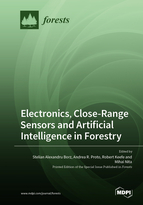Electronics, Close-Range Sensors and Artificial Intelligence in Forestry
A special issue of Forests (ISSN 1999-4907). This special issue belongs to the section "Forest Inventory, Modeling and Remote Sensing".
Deadline for manuscript submissions: closed (12 June 2022) | Viewed by 48356
Special Issue Editors
Interests: wood and biomass supply chain optimization; sensor technology; transport optimization; forest planning
Special Issues, Collections and Topics in MDPI journals
Interests: forest mechanization; productivity; NDT evaluation and wood quality; measuring wood properties; wood technology; wood engineering; urban forestry; agro-forestry biomass; sustainable agro-forestry management
Special Issues, Collections and Topics in MDPI journals
Interests: remote sensing; GIS; forest and water; forest management; machine learning
Special Issues, Collections and Topics in MDPI journals
Special Issue Information
Dear colleagues,
The use of electronics, close-range sensing and artificial intelligence has changed the management paradigm in many of the current industries, in which big-data analytics by automated processes has become the backbone of decision making and improvement. Acknowledging the integration of electronics, devices, sensors and intelligent algorithms in many of the equipment used in forest operations, as well as their use in various forestry-related applications, reality is showing us that many of the applications of forest engineering still rely on data collected traditionally, which is resource-intensive, demanding analysis and, in many cases, being limited to establishing the specific behaviors of forest product systems and wood supply chain. This situation is often preventing from developing solutions for improvement or to accurately infer the laws behind the operation and management of such systems. In particular, partly mechanized systems, environmental impact assessment and ergonomics of operation are components or disciplines in which improvement is crucial and which could rely on new advancements in algorithms, computers, electronics and sensor science to find solutions, by robust solutions, to these pressing needs. This Special Issue is intended to cover the whole range of applications, as is typical to forestry and forest engineering in which one or more of the following could be addressed by high-quality research or review papers:
- Moving from traditional to computer-aided time consumption and productivity studies and models, and from traditional to advanced methods to estimate forest growth, production, dynamics and disturbance;
- Enhancing big-data collection, analysis and augmentation using integrated or external electronics, computers and sensor systems;
- Development, validation, and use of human and forestry equipment activity recognition models developed using smart watches, smart phones, micro-electric sensors and Internet-of-Things devices;
- Applications of virtual reality, teleoperation, telematics, and robotics in forestry;
- Application of close-range sensing to solve important problems in forestry and forest operations, such as those related to productivity, ergonomics and environmental impact assessment;
- Development and/or implementation of intelligent algorithms and artificial intelligence (AI) for multivariate analyses, classification and event-based management in forestry and forest engineering;
- Adapting and implementing low-cost solutions to answer the pressing problems in the wood supply chain and to overcome bottlenecks;
- Intelligent methods, devices, equipment, machines, protocols, processes and robots that have a direct application or use in forestry;
- Effects of automation on the environment and human welfare.
Dr. Andrea Rosario Proto
Dr. Robert Keefe
Dr. Mihai Nita
Guest Editors
Manuscript Submission Information
Manuscripts should be submitted online at www.mdpi.com by registering and logging in to this website. Once you are registered, click here to go to the submission form. Manuscripts can be submitted until the deadline. All submissions that pass pre-check are peer-reviewed. Accepted papers will be published continuously in the journal (as soon as accepted) and will be listed together on the special issue website. Research articles, review articles as well as short communications are invited. For planned papers, a title and short abstract (about 100 words) can be sent to the Editorial Office for announcement on this website.
Submitted manuscripts should not have been published previously, nor be under consideration for publication elsewhere (except conference proceedings papers). All manuscripts are thoroughly refereed through a single-blind peer-review process. A guide for authors and other relevant information for submission of manuscripts is available on the Instructions for Authors page. Forests is an international peer-reviewed open access monthly journal published by MDPI.
Please visit the Instructions for Authors page before submitting a manuscript. The Article Processing Charge (APC) for publication in this open access journal is 2600 CHF (Swiss Francs). Submitted papers should be well formatted and use good English. Authors may use MDPI's English editing service prior to publication or during author revisions.
Keywords
- forest operations
- productivity
- ergonomics
- environmental impact assessment
- close-range
- sensors
- big data
- virtual reality
- teleoperation
- automation
- artificial intelligence
- forestry 4.0









